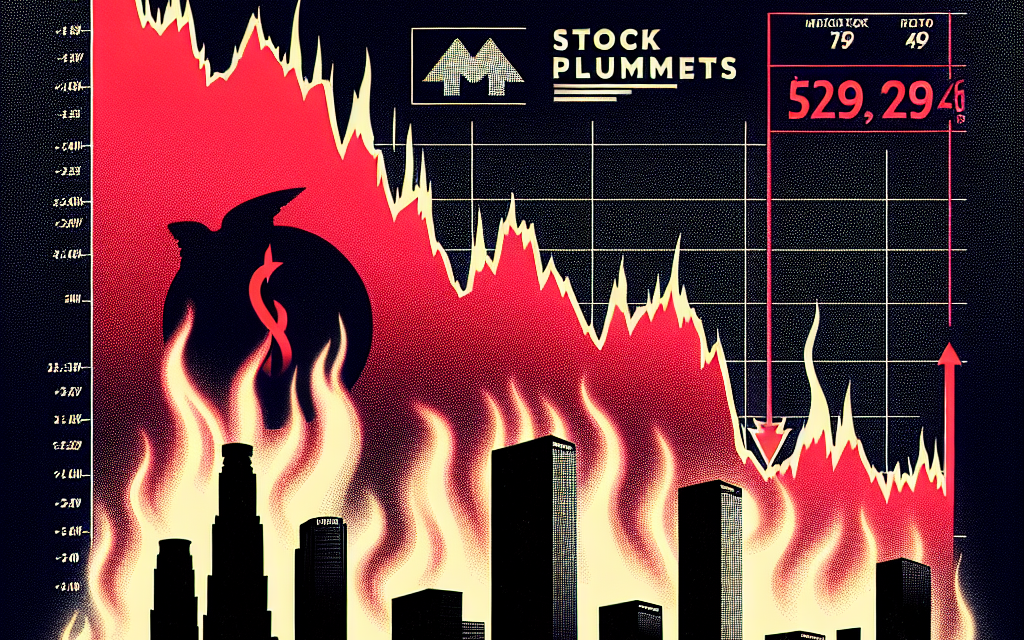“Mercury General Stock Plummets: L.A. Fires Ignite Financial Turmoil for the Insurer.”
Introduction
Mercury General, a prominent auto and home insurance provider, has recently experienced a significant decline in its stock value, largely attributed to the devastating wildfires in Los Angeles. These fires have not only caused widespread destruction but have also raised concerns about the financial stability of insurers facing increased claims and liabilities. As the company grapples with the aftermath of these catastrophic events, investors are closely monitoring the implications for Mercury General’s profitability and long-term viability in a changing climate. The situation underscores the broader challenges faced by the insurance industry in managing risk and adapting to the growing frequency of natural disasters.
Mercury General’s Stock Decline: Analyzing the Numbers
In recent weeks, the stock of Mercury General has experienced a significant decline, a development that has raised concerns among investors and analysts alike. This downturn can be largely attributed to the devastating wildfires that have swept through Los Angeles and surrounding areas, leading to a surge in claims that the insurer must address. As the fires raged, the financial implications for Mercury General became increasingly apparent, prompting a closer examination of the numbers behind this troubling trend.
To begin with, it is essential to understand the scale of the wildfires and their impact on the insurance industry. The fires have not only caused widespread destruction of property but have also resulted in a substantial increase in claims filed by policyholders. As a result, Mercury General, which specializes in auto and homeowners insurance, has found itself facing a daunting financial burden. The company’s exposure to these catastrophic events has led to a reevaluation of its risk management strategies, as the costs associated with claims can significantly affect profitability.
Moreover, the stock market’s reaction to these developments has been swift and severe. Following the onset of the fires, Mercury General’s stock price plummeted, reflecting investor concerns about the company’s ability to manage the financial fallout. Analysts have noted that the decline in stock value is not merely a reaction to the immediate costs associated with the fires but also a reflection of broader concerns regarding the company’s long-term viability in an increasingly volatile climate. This situation has prompted many investors to reassess their positions, leading to further selling pressure on the stock.
In addition to the immediate financial implications, the wildfires have also raised questions about the adequacy of Mercury General’s reserves. Insurers are required to maintain sufficient reserves to cover potential claims, and the unexpected scale of the fires has put these reserves to the test. As claims continue to pour in, the company may need to bolster its reserves, which could further strain its financial resources. This necessity could lead to a reevaluation of its pricing strategies, potentially resulting in higher premiums for policyholders in the future.
Furthermore, the decline in stock price has implications for Mercury General’s overall market position. As investors lose confidence, the company may find it more challenging to attract new capital or maintain favorable credit ratings. This situation could hinder its ability to invest in growth opportunities or innovate its product offerings, ultimately impacting its competitive edge in the insurance market. The interconnectedness of these factors underscores the complexity of the challenges facing Mercury General in the wake of the wildfires.
In conclusion, the recent decline in Mercury General’s stock can be attributed to a confluence of factors stemming from the devastating wildfires in Los Angeles. The immediate financial burden of increased claims, coupled with concerns about the adequacy of reserves and long-term viability, has created a challenging environment for the insurer. As the situation continues to evolve, stakeholders will be closely monitoring the company’s response and its ability to navigate these turbulent waters. The interplay between natural disasters and the insurance industry serves as a stark reminder of the inherent risks involved, highlighting the need for robust risk management strategies in an era of increasing environmental unpredictability.
The Role of Natural Disasters in Insurance Valuation
Natural disasters have long been a significant factor in the valuation of insurance companies, influencing both their financial stability and market perception. The recent plummet in Mercury General’s stock, attributed to the devastating fires in Los Angeles, serves as a stark reminder of how environmental catastrophes can reshape the landscape of the insurance industry. As these events become increasingly frequent and severe due to climate change, insurers must navigate a complex web of risks that directly impact their operations and profitability.
When a natural disaster strikes, the immediate financial implications for insurers can be profound. Claims from policyholders can surge, leading to substantial payouts that may exceed the company’s reserves. In the case of the L.A. fires, Mercury General faced a wave of claims from homeowners and businesses affected by the destruction. This sudden influx of claims not only strains the insurer’s financial resources but also raises concerns among investors about the company’s ability to manage its liabilities effectively. Consequently, stock prices may react negatively as market participants reassess the insurer’s risk profile and future earnings potential.
Moreover, the valuation of insurance companies is closely tied to their underwriting practices and risk assessment models. Insurers like Mercury General must continuously evaluate their exposure to natural disasters, adjusting their premiums and coverage terms accordingly. However, accurately predicting the frequency and severity of such events poses a significant challenge. As climate patterns shift, traditional models may become less reliable, leading to potential underpricing of risk. This miscalculation can result in financial strain during catastrophic events, further exacerbating the impact on stock valuations.
In addition to immediate financial repercussions, natural disasters can also influence an insurer’s long-term strategy. Companies may find themselves compelled to reassess their geographic footprint, potentially withdrawing from high-risk areas or adjusting their product offerings. For instance, in response to the increasing threat of wildfires, insurers might implement stricter underwriting guidelines or raise premiums for properties located in fire-prone regions. While these measures can help mitigate risk, they may also alienate customers and reduce market share, creating a delicate balance between profitability and customer retention.
Furthermore, the regulatory environment plays a crucial role in shaping how insurers respond to natural disasters. In the aftermath of significant events, regulators often scrutinize insurers’ practices, ensuring that they maintain adequate reserves and fulfill their obligations to policyholders. This oversight can lead to increased operational costs and compliance burdens, further impacting an insurer’s financial health. As seen with Mercury General, the combination of heightened scrutiny and rising claims can create a perfect storm, leading to a sharp decline in stock value.
In conclusion, the interplay between natural disasters and insurance valuation is complex and multifaceted. The recent decline in Mercury General’s stock highlights the vulnerabilities that insurers face in an increasingly volatile climate. As natural disasters become more frequent and severe, insurers must adapt their strategies, refine their risk assessment models, and navigate regulatory challenges to maintain financial stability. Ultimately, the ability to effectively manage these risks will determine not only the resilience of individual companies but also the overall health of the insurance industry in the face of an uncertain future.
L.A. Fires: A Case Study in Risk Management for Insurers
The recent wildfires in Los Angeles have underscored the intricate relationship between natural disasters and the insurance industry, particularly highlighting the vulnerabilities faced by insurers like Mercury General. As the flames engulfed vast areas, the immediate impact on property and lives was devastating, but the repercussions extended far beyond the physical destruction. For insurers, these events serve as a critical case study in risk management, revealing both the challenges and the strategies necessary to navigate such crises.
In the wake of the L.A. fires, Mercury General experienced a significant decline in its stock value, a reflection of investor concerns regarding the company’s ability to manage the financial fallout from the disaster. This situation illustrates a broader trend within the insurance sector, where catastrophic events can lead to substantial claims that threaten the financial stability of insurers. The fires not only resulted in property damage but also raised questions about the adequacy of existing risk assessment models. Insurers must grapple with the reality that traditional methods may not fully account for the increasing frequency and intensity of wildfires, driven in part by climate change.
Moreover, the L.A. fires serve as a reminder of the importance of proactive risk management strategies. Insurers like Mercury General must continuously refine their underwriting processes to better evaluate the risks associated with insuring properties in high-risk areas. This involves not only assessing the physical characteristics of the properties but also considering broader environmental factors and historical data on fire incidents. By adopting a more comprehensive approach to risk assessment, insurers can better position themselves to withstand the financial pressures that arise from catastrophic events.
In addition to refining risk assessment models, insurers must also enhance their claims management processes. The aftermath of the L.A. fires has highlighted the need for efficient and effective claims handling, as policyholders seek timely compensation for their losses. Insurers that can streamline their claims processes and provide clear communication during crises are more likely to maintain customer trust and loyalty. This is particularly crucial in a competitive market where consumers have numerous options for coverage.
Furthermore, the L.A. fires have prompted discussions about the role of reinsurance in mitigating risk for primary insurers. Reinsurance allows insurers to transfer a portion of their risk to other companies, thereby providing a buffer against large-scale claims. As the frequency of natural disasters increases, the importance of reinsurance becomes even more pronounced. Insurers must evaluate their reinsurance strategies to ensure they are adequately protected against potential losses stemming from catastrophic events.
In conclusion, the recent wildfires in Los Angeles have served as a stark reminder of the challenges faced by insurers like Mercury General in managing risk. The plummeting stock value of the company reflects broader concerns within the industry regarding the adequacy of risk assessment models and claims management processes. As the insurance landscape continues to evolve in response to climate change and increasing natural disasters, it is imperative for insurers to adopt proactive strategies that enhance their resilience. By refining their risk assessment methods, improving claims handling, and leveraging reinsurance, insurers can better navigate the complexities of a changing environment and safeguard their financial stability in the face of future challenges.
Investor Reactions to Mercury General’s Financial Outlook
The recent plummet in Mercury General’s stock has sent ripples through the investment community, particularly in light of the devastating fires that have swept through Los Angeles. As an insurer, Mercury General is acutely aware of the financial implications that natural disasters can impose on its operations. Investors, therefore, are closely scrutinizing the company’s financial outlook in the wake of these catastrophic events. The fires have not only caused significant property damage but have also raised concerns about the adequacy of the insurer’s reserves and its ability to manage claims effectively.
In the immediate aftermath of the fires, investors reacted swiftly, leading to a notable decline in Mercury General’s stock price. This reaction can be attributed to a combination of factors, including fears of increased claims payouts and the potential for a long-term impact on the company’s profitability. As the fires continue to wreak havoc, the uncertainty surrounding the total cost of claims has left many investors apprehensive. The market’s response reflects a broader concern about the insurer’s capacity to absorb such losses without compromising its financial stability.
Moreover, analysts have begun to reassess their projections for Mercury General, taking into account the heightened risk environment created by climate change and the increasing frequency of natural disasters. This reassessment has led to a more cautious outlook, with some analysts downgrading their ratings on the stock. The potential for rising insurance premiums, while a possible remedy for the company, also raises questions about customer retention and market competitiveness. Investors are acutely aware that any significant increase in premiums could drive policyholders to seek coverage from competitors, further complicating Mercury General’s recovery efforts.
In addition to the immediate financial implications, the fires have also sparked discussions about the long-term viability of the insurance model in areas prone to such disasters. Investors are beginning to consider how Mercury General and other insurers will adapt to an evolving risk landscape. The company’s response to this crisis will be critical in shaping investor confidence moving forward. If Mercury General can demonstrate effective claims management and a robust strategy for mitigating future risks, it may be able to regain some of the lost trust among investors.
Furthermore, the broader economic context cannot be overlooked. The fires have not only impacted individual policyholders but have also strained local economies. As businesses face disruptions and residents grapple with displacement, the ripple effects on the insurance market could be profound. Investors are keenly aware that a weakened local economy may lead to increased defaults on insurance premiums, further complicating Mercury General’s financial outlook.
As the situation continues to unfold, investor sentiment remains cautious. Many are adopting a wait-and-see approach, closely monitoring the company’s response to the crisis and its ability to navigate the challenges ahead. The potential for regulatory changes in the insurance industry, driven by the increasing frequency of natural disasters, adds another layer of complexity to the investment landscape. In this context, Mercury General’s ability to adapt and innovate will be paramount in restoring investor confidence and stabilizing its stock price.
In conclusion, the impact of the Los Angeles fires on Mercury General has been profound, prompting significant investor reactions and raising critical questions about the insurer’s financial outlook. As the company grapples with the immediate aftermath of the disaster, its future will depend on its strategic responses and the broader economic environment. Investors will be watching closely, as the unfolding narrative will ultimately shape their perceptions and decisions regarding Mercury General’s stock.
The Future of Insurance Stocks Amid Climate Change
The recent plummet of Mercury General stock serves as a stark reminder of the profound impact that climate change and natural disasters can have on the insurance industry. As wildfires rage across California, particularly in Los Angeles, insurers are grappling with the financial repercussions of increased claims and the need to reassess their risk models. This situation raises critical questions about the future of insurance stocks in an era marked by escalating climate-related events.
As the frequency and intensity of wildfires rise, insurers like Mercury General are forced to confront the reality of their exposure to catastrophic losses. The recent fires in Los Angeles have not only led to significant property damage but have also strained the resources of insurance companies, which must process a surge of claims while maintaining their financial stability. This scenario highlights a broader trend within the insurance sector, where traditional risk assessment models are becoming increasingly inadequate in the face of climate change. Insurers are now compelled to adopt more sophisticated approaches to risk management, which may involve recalibrating premiums and coverage options to reflect the heightened risks associated with climate-related events.
Moreover, the volatility of insurance stocks in response to natural disasters underscores the interconnectedness of environmental factors and financial markets. Investors are becoming more aware of the risks posed by climate change, leading to a reevaluation of their portfolios. As a result, insurance companies that fail to adapt to the changing landscape may find themselves facing not only increased claims but also diminished investor confidence. This shift in sentiment can lead to significant stock price fluctuations, as seen with Mercury General, where the stock’s decline reflects broader concerns about the sustainability of the insurer’s business model in a warming world.
In light of these challenges, the future of insurance stocks may hinge on the industry’s ability to innovate and respond proactively to climate risks. Insurers are increasingly exploring new technologies and data analytics to enhance their understanding of risk exposure. For instance, advancements in satellite imagery and predictive modeling can provide valuable insights into potential losses from natural disasters, enabling insurers to make more informed underwriting decisions. By leveraging these tools, companies can better align their pricing strategies with the realities of climate change, potentially stabilizing their stock performance in the long run.
Furthermore, the growing emphasis on environmental, social, and governance (ESG) criteria among investors is reshaping the landscape for insurance companies. Insurers that prioritize sustainability and demonstrate a commitment to mitigating climate risks may attract a more conscientious investor base. This shift could lead to a divergence in stock performance, where companies that proactively address climate challenges may outperform their peers. As such, the ability to integrate ESG principles into business strategies will likely become a critical factor in determining the resilience and profitability of insurance stocks.
In conclusion, the recent decline in Mercury General’s stock serves as a cautionary tale for the insurance industry amid the realities of climate change. As natural disasters become more frequent and severe, insurers must adapt their risk management practices and embrace innovative solutions to remain viable. The future of insurance stocks will depend not only on how well companies navigate these challenges but also on their ability to align with evolving investor expectations regarding sustainability and risk management. As the industry moves forward, those that prioritize resilience and adaptability will be better positioned to thrive in an increasingly unpredictable environment.
Regulatory Implications for Insurers After Major Disasters
The recent plummet of Mercury General’s stock has drawn significant attention, particularly in light of the devastating fires that have swept through Los Angeles. As the insurer grapples with the financial repercussions of these disasters, it is essential to consider the broader regulatory implications that arise for insurers in the aftermath of such catastrophic events. The interplay between natural disasters and insurance regulation is complex, often leading to a reevaluation of existing policies and practices.
In the wake of major disasters, regulators typically scrutinize the financial stability of insurers to ensure they can meet their obligations to policyholders. This scrutiny is particularly pertinent for companies like Mercury General, which may face an influx of claims as affected individuals seek compensation for losses incurred during the fires. The immediate challenge for insurers is to maintain adequate reserves to cover these claims while also managing their overall financial health. Consequently, regulators may impose stricter capital requirements or mandate enhanced risk management practices to safeguard the interests of policyholders.
Moreover, the regulatory landscape often shifts in response to the frequency and severity of natural disasters. As climate change continues to exacerbate the intensity of such events, regulators may find it necessary to adapt existing frameworks to better address the evolving risks faced by insurers. This could involve revising underwriting guidelines, adjusting premium rates, or even implementing new models for assessing risk. For instance, insurers may be required to incorporate more sophisticated data analytics into their risk assessment processes, allowing them to better predict potential losses and adjust their strategies accordingly.
In addition to financial stability, regulators are also concerned with the fairness and transparency of the claims process. Following a disaster, there is often a surge in claims, which can lead to delays and disputes over coverage. To mitigate these issues, regulators may establish guidelines that promote timely claims processing and ensure that policyholders receive fair treatment. This focus on consumer protection is crucial, as it helps to maintain public trust in the insurance industry, particularly during times of crisis.
Furthermore, the regulatory response to disasters can also extend to the broader insurance market. For example, if a significant number of insurers experience financial strain due to catastrophic events, regulators may need to consider measures to stabilize the market. This could involve facilitating mergers or acquisitions among insurers, or even creating state-backed reinsurance programs to help spread the risk associated with large-scale disasters. Such interventions aim to prevent market disruptions that could leave policyholders vulnerable and ensure that the insurance industry remains resilient in the face of increasing challenges.
As the situation with Mercury General unfolds, it serves as a poignant reminder of the interconnectedness between natural disasters, insurance companies, and regulatory bodies. The implications of the L.A. fires extend beyond immediate financial losses; they highlight the need for a proactive regulatory approach that anticipates future challenges. By fostering a regulatory environment that encourages sound risk management practices and prioritizes consumer protection, stakeholders can work together to enhance the resilience of the insurance industry. Ultimately, the lessons learned from this incident may pave the way for more robust regulatory frameworks that better equip insurers to navigate the complexities of an increasingly volatile climate landscape.
Strategies for Insurers to Mitigate Losses from Wildfires
The recent plummet in Mercury General’s stock, attributed to the devastating wildfires in Los Angeles, underscores the pressing need for insurers to adopt effective strategies to mitigate losses associated with such catastrophic events. As climate change continues to exacerbate the frequency and intensity of wildfires, insurers must proactively address the risks involved. One of the most critical strategies involves enhancing risk assessment and underwriting processes. By utilizing advanced data analytics and geographic information systems, insurers can better evaluate the risk profiles of properties in fire-prone areas. This approach allows for more accurate pricing of premiums and the identification of high-risk zones, enabling insurers to make informed decisions about coverage offerings.
In addition to improved risk assessment, insurers can also invest in technology that aids in real-time monitoring of wildfire conditions. By leveraging satellite imagery and predictive modeling, companies can gain insights into potential fire outbreaks and their trajectories. This information is invaluable for timely intervention and can help insurers manage claims more effectively. Furthermore, by collaborating with local fire departments and emergency services, insurers can develop response plans that prioritize the protection of insured properties, thereby reducing potential losses.
Another essential strategy is the promotion of risk mitigation measures among policyholders. Insurers can incentivize homeowners to implement fire-resistant landscaping, install firebreaks, and utilize non-combustible building materials. By offering discounts on premiums for those who take proactive steps to reduce their fire risk, insurers not only protect their bottom line but also foster a culture of safety and preparedness within communities. Education campaigns that inform policyholders about the importance of creating defensible space around their homes can further enhance these efforts.
Moreover, insurers should consider diversifying their portfolios to spread risk across different geographic areas. By not concentrating too much exposure in high-risk regions, companies can cushion themselves against significant losses from localized disasters. This diversification can be achieved through strategic partnerships or by expanding into markets less prone to wildfires. Additionally, reinsurance plays a crucial role in managing risk. By transferring a portion of their risk to reinsurers, primary insurers can stabilize their financial performance in the face of catastrophic events.
Furthermore, engaging in community resilience initiatives can also be beneficial. Insurers can collaborate with local governments and organizations to support fire prevention programs, such as controlled burns and vegetation management. By investing in community resilience, insurers not only contribute to the overall safety of the areas they serve but also create a more stable environment for their business operations.
Lastly, continuous evaluation and adaptation of strategies are vital in the ever-evolving landscape of wildfire risk. Insurers must remain vigilant and responsive to new data and trends, adjusting their approaches as necessary. This adaptability will be crucial in maintaining financial stability and ensuring that they can meet the needs of their policyholders in the aftermath of disasters.
In conclusion, the challenges posed by wildfires necessitate a multifaceted approach from insurers. By enhancing risk assessment, investing in technology, promoting mitigation measures, diversifying portfolios, engaging in community initiatives, and remaining adaptable, insurers can better navigate the complexities of wildfire-related losses. As the industry faces increasing pressure from climate change, these strategies will be essential for sustaining operations and protecting both their financial interests and the communities they serve.
Q&A
1. **What caused Mercury General’s stock to plummet?**
– The stock plummeted due to significant losses anticipated from claims related to the recent wildfires in Los Angeles.
2. **How much did Mercury General’s stock drop?**
– The stock dropped approximately 15% following the announcement of the expected losses.
3. **What is the estimated financial impact of the L.A. fires on Mercury General?**
– The estimated financial impact is in the range of hundreds of millions of dollars in claims.
4. **How do wildfires typically affect insurance companies like Mercury General?**
– Wildfires lead to increased claims for property damage, which can significantly affect an insurer’s financial stability and stock performance.
5. **What measures might Mercury General take in response to the losses?**
– Mercury General may consider raising premiums, reducing coverage, or tightening underwriting standards to mitigate future risks.
6. **How have investors reacted to the news of the stock drop?**
– Investors have shown concern, leading to increased selling pressure on the stock as they reassess the company’s risk exposure.
7. **What long-term effects could the L.A. fires have on Mercury General?**
– Long-term effects may include a reevaluation of risk models, potential changes in market share, and ongoing volatility in stock performance due to future wildfire risks.
Conclusion
The plummet of Mercury General’s stock can be attributed to the significant financial strain caused by the recent wildfires in Los Angeles, which have led to increased claims and potential liabilities for the insurer. The combination of rising operational costs and the uncertainty surrounding future wildfire risks has raised concerns among investors, resulting in a sharp decline in stock value. This situation underscores the vulnerability of insurance companies to natural disasters and the broader implications for their financial stability and market performance.





